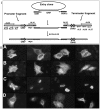PhosphoregDB: the tissue and sub-cellular distribution of mammalian protein kinases and phosphatases
- PMID: 16504016
- PMCID: PMC1395337
- DOI: 10.1186/1471-2105-7-82
PhosphoregDB: the tissue and sub-cellular distribution of mammalian protein kinases and phosphatases
Abstract
Background: Protein kinases and protein phosphatases are the fundamental components of phosphorylation dependent protein regulatory systems. We have created a database for the protein kinase-like and phosphatase-like loci of mouse http://phosphoreg.imb.uq.edu.au that integrates protein sequence, interaction, classification and pathway information with the results of a systematic screen of their sub-cellular localization and tissue specific expression data mined from the GNF tissue atlas of mouse.
Results: The database lets users query where a specific kinase or phosphatase is expressed at both the tissue and sub-cellular levels. Similarly the interface allows the user to query by tissue, pathway or sub-cellular localization, to reveal which components are co-expressed or co-localized. A review of their expression reveals 30% of these components are detected in all tissues tested while 70% show some level of tissue restriction. Hierarchical clustering of the expression data reveals that expression of these genes can be used to separate the samples into tissues of related lineage, including 3 larger clusters of nervous tissue, developing embryo and cells of the immune system. By overlaying the expression, sub-cellular localization and classification data we examine correlations between class, specificity and tissue restriction and show that tyrosine kinases are more generally expressed in fewer tissues than serine/threonine kinases.
Conclusion: Together these data demonstrate that cell type specific systems exist to regulate protein phosphorylation and that for accurate modelling and for determination of enzyme substrate relationships the co-location of components needs to be considered.
Figures






References
-
- Bubulya PA, Prasanth KV, Deerinck TJ, Gerlich D, Beaudouin J, Ellisman MH, Ellenberg J, Spector DL. Hypophosphorylated SR splicing factors transiently localize around active nucleolar organizing regions in telophase daughter nuclei. J Cell Biol. 2004;167:51–63. doi: 10.1083/jcb.200404120. - DOI - PMC - PubMed
Publication types
MeSH terms
Substances
Grants and funding
LinkOut - more resources
Full Text Sources

